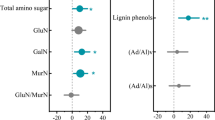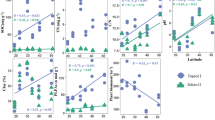Abstract
The alien woody legume, black locust (Robinia pseudoacacia), has invaded Japanese black pine (Pinus thunbergii) forests located in Japan’s coastal plain and hill regions where gaps are formed in pine forests after nematode infestation. Nitrogen fixation by legumes accelerates N cycling in forest ecosystems. We studied temporal change in the annual tree-ring resolution N stable isotope composition (δ15N, a per mil deviation of δ15N/14N ratio, relative to atmospheric N2δ15N=0‰) at two natural locations of Japanese black pine forest with black locust that differed in the time since black locust establishment (Shohnai in northeast and Kita-Kyushu in southwest Japan). Analyzed tree-rings covered the period from 1990/1992 to 2009. N acquisition by Japanese black pine from black locust N input to the soil was evidenced by temporal shifting of N stable isotope composition on the annual pine tree rings. With progressive development of the forest stand, δ15N values of earlier tree-rings δ15N of −5‰) from black pine associated with black locust shifted towards values similar to those of black locust δ15N values nearly to −1‰), which suggests acquisition of N by N2 fixation (Shohnai site). In contrast, in a forest where black locust had settled for two or three generations, in a black pine stand (Kita-Kyushu site), longer periods of N enrichment in the soil were reflected in the elevated tree-ring δ15N values of newly established black pine trees. Based on tree-ring δ15N data from the Shohnai site, we determined that about 10 years after black locust establishment, soil N had already been enriched by black locust N, this, in turn, contributed to N fertilization of surrounding trees in mixed stands.
Similar content being viewed by others
References
Boddey RM, Peoples MB, Palmer B, Dart P. 2000. Use of the 15N natural abundance technique to quantify biological nitrogen fixation by woody perennials. Nutr Cycl Agroecosys, 57: 235–270.
Bouillet JP, Laclau JP, Gonçalves JLM, Moreira MZ, Trivelin PCO, Jourdan C, Silva EV, Piccolo MC, Tsai SM, Galiana A. 2008. Mixed-species plantations of Acacia mangium and Eucalyptus grandis in Brazil. 2: Nitrogen accumulation in the stands and biological N2 fixation. For Ecol Manag, 255: 3918–3930.
Couto-Vazquez A, Gonzalez-Prieto SJ. 2010. Effects of climate, tree age, dominance and growth on δ15N in young pinewoods. Trees, 24: 507–514.
Danso SKA, Zapata F, Awonaike KO. 1955. Measurement of biological N2 fixation in field-grown Robinia pseudoacacia L. Soil Biol Biochem, 27: 415–419.
Doucet A, Savard MM, Begin C, Smirnoff A. 2011. Is wood pre-treatment essential for tree-ring nitrogen concentration and isotope analysis? Rapid Commu Mass Spectr, 25: 469–475.
Fukuzaki N, Hayasaka H. 2009. Seasonal variations of nitrogen isotope ratios of ammonium and nitrate in precipitations collected in the Yahiko-Kakuda mountains area in Niigata prefecture, Japan. Water, Air, Soil Pollut, 203: 391–397.
Gebauer G, Schulze ED. 1991. Carbon and nitrogen isotope ratios in different compartments of a healthy and declining Picea abies forest in the Fichtelgebirge, NE Bavaria. Oecologia, 87: 198–207.
Gyokusen K, Iijima Y, Yahata H. 1991. Spatial distribution and morphological features of root systems in Niseakashia (Robinia pseudo-acacia L.) growing under a coastal black pine forest. Bull Kyushu Univ Forests, 64: 13–28. (In Japanese)
Hart SC, Classen AT. 2003. Potential for assessing long-term dynamics in soil nitrogen availability from variations in δ15N of tree rings. Isotopes Environ Health Stud, 39: 15–28.
Kawata H. 1987. Difference of nutrient amounts returned to soil by litter falls and their effects on soil properties between Pinus thunbergii and Robinia pseudoacacia forests in coastal sand dune. Bull Niigata Univ For, 20: 51–56. (In Japanese)
Lopez CML, Mizota C, Yamanaka T, Nobori Y. 2010. Temporal changes in tree-ring nitrogen of Pinus thunbergii trees exposed to Black-tailed Gull (Larus crassirostris) breeding colonies. Appl Geochem, 25: 1699–1702.
Lopez CML, Mizota C, Yamanaka T, Nobori Y. 2011. Effects of pre-treatment on the nitrogen isotope composition of Japanese black pine (Pinus thunbergii) tree-rings as affected by high N input. Rapid Commu Mass Spectr, 25: 3298–3302.
Malcolm GM, Bush DS, Rice SK. 2008. Soil nitrogen conditions approach preinvasion levels following restoration of nitrogen-fixing black locust (Robinia pseudoacacia) stands in a pine-oak ecosystem. Restor Ecol, 16: 70–78.
Mizota C, Lopez CML, Yamanaka T, Nobori Y. 2011. Differential response of two Pinus spp. to avian nitrogen input as revealed by nitrogen isotope analysis for tree-rings. Isot Environ Health Stud, 47: 62–70.
Montagnini F, Haines B, Boring L, Swank W. 1986. Nitrification potentials in early successional black locust and in mixed hardwood forest stands in the southern Appalachians, USA. Biogeochemistry, 2: 197–210.
Moon HS, Haruki M. 1999. Nutrient distribution and content in plant tissue, forest floor, and litterfall in four pioneer stands on volcano Mt. Showa-Shinzan. J For Environ, 41: 7–11.
Natelhoffer KJ, Fry B. 1988. Controls on natural nitrogen-15 and carbon-13 abundances in forest soil organic matter. Soil Sci Soc Am J, 52: 1633–1640.
Poulson SR, Chamberlain CP, Friedland AJ. 1995. Nitrogen isotope variation of tree rings as a potential indicator of environmental change. Chem Geol (Iso. Geosci. Sec.), 125: 307–315.
Rice SK, Westerman B, Federici R. 2004. Impacts of the exotic, nitrogen-fixing black locust (Robinia pseudoacacia) on nitrogen-cycling in a pine-oak ecosystem. Plant Ecol, 174: 97–107.
Robinson D. 2001. δ15N as an integrator of the nitrogen cycle. Trends Ecol Evol, 16: 153–162.
Sauer M, Cherubini P, Ammann M, De Cinti B, Siegwolf R. 2004. First detection of nitrogen from NOx in tree rings: a 15N/14N study near a motorway. Atmosp Environ, 38: 2779–2787.
Savard MM. 2010. Tree-ring stable isotopes and historical perspectives on pollution — An overview. Environ Pollu, 158: 2007–2013.
Schulze ED, Gebauer G, Ziegler H, Lange OL. 1991. Estimates of nitrogen fixation by trees on an aridity gradient in Namibia. Oecologia, 88: 451–455.
Schulze ED. 2000.Carbon and nitrogen cycling in European forest ecosystems. Ecological Studies, 142: 3–13.
Taniguchi T, Tamai S, Yamanaka N, Futai K. 2007. Inhibition of the regeneration of Japanese black pine (Pinus thunbergii) by black locust (Robinia pseudoacacia) in coastal sand dunes. J For Res, 12: 350–357.
Author information
Authors and Affiliations
Corresponding author
Rights and permissions
About this article
Cite this article
Lopez C, M.L., Mizota, C., Nobori, Y. et al. Temporal changes in nitrogen acquisition of Japanese black pine (Pinus thunbergii) associated with black locust (Robinia pseudoacacia). Journal of Forestry Research 25, 585–589 (2014). https://doi.org/10.1007/s11676-014-0498-2
Received:
Accepted:
Published:
Issue Date:
DOI: https://doi.org/10.1007/s11676-014-0498-2




